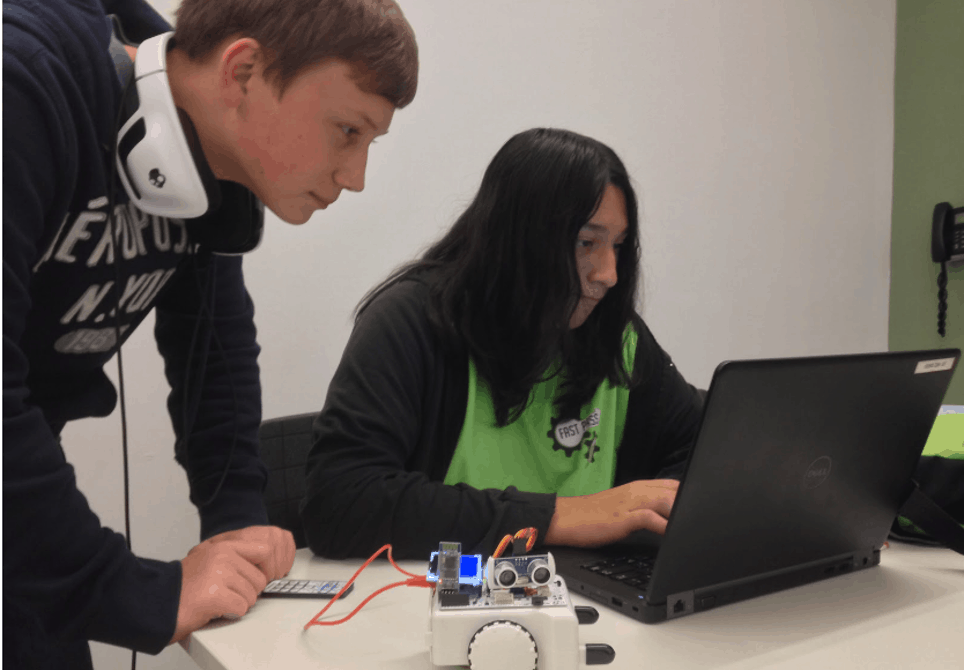Smart Review | Sparking Student Coding Skills with the Sparki Robot

The Sparki programmable robot by ArcBotics is an engaging and rewarding introduction to computer programming and robotics.
Designed to be user-friendly and highly manipulable, the roughly 5- inch cube- shaped robot features large wheels that can climb and pivot, grippers for grasping pens or other objects, an LED display, sound, a swiveling head with a distance sensor and 30 other programmable sensors and parts. All of these features can be programmed with computer code or controlled with a remote control.
Much of the circuitry is exposed, making the mystery associated with electronic devices more visible. While this may lend a certain fragility to the robot, I think it’s a good tradeoff as it helps users better conceptualize the workings of the robot; it’s not all hidden by a sleek, glassy facade and I think this sets Sparki apart as a learning tool. It also was ready to use within minutes–no assembly required.
The instructions for Sparki are all accessible through the ArcBotics website. To get started, the user downloads programming software (available for Windows, iOS and Linux), and there are several coding formats available depending on the user’s experience level. I downloaded the SparkiDuino software, which uses C/C++. There are many sample lessons available on the ArcBotics website, and as a beginner myself, I started with some beginner coding commands.
Code is uploaded directly to Sparki via the USB cable provided. Within minutes, I had taught Sparki to go forward, backward and turn. My seven-year-old son might not be quite ready for coding, but he immediately fell in love with Sparki, using the remote to move it, activate the lights and grasp objects with the grippers.
 When I hit a stumbling block, I brought Sparki to school and gave a couple of my ninth-grade students free rein with it. After uploading the software (SparkiDuino, based on Arduino,) they quickly had surpassed my coding skills.
When I hit a stumbling block, I brought Sparki to school and gave a couple of my ninth-grade students free rein with it. After uploading the software (SparkiDuino, based on Arduino,) they quickly had surpassed my coding skills.
Instructions for Sparki caution users to place it on the floor instead of a table, but my student, Ivan, programmed it to sense the edge of a table using the infrared sensor on the front of Sparki. He reported that with his JavaScript background he was able to learn the basic coding language for Sparki in about an hour.
In terms of constructive feedback, Ivan suggested that Sparki have sensors in the back as well as the front (when he programmed the “edge sensing” commands, Sparki would stop at an edge but then reverse, possibly falling off in the other direction.)
He also wondered about the grippers having a sensor that would stop their motor when an object was firmly grasped, so as to avoid running down the battery. He and my other student, Luis, both liked that the remote control could also be programmed to do customized functions.
I think that Sparki is a product that could really be transformative for students who need to see the physical results of coding beyond a computer screen. It is rewarding to create coded commands and see them translated into action!
All teachers, I believe it safe to say, value problem solving, and Sparki is an outstanding tool that helps students perform coding experiments and see the results almost immediately. And Sparki’s “minimal coverage” design teaches students that what machines do is not magic; it’s science.
For more, see:
- Smart Review | SAM Labs Inventor Kit
- Smart Review | The Wild Robot and Talking to Kids about AI
- Smart Review | littleBits STEAM Student Set & STEAM Teacher PD
Arcbotics provided the Sparki robot for this review, and is currently offering Sparki in limited quantities to all teachers for a 60-Day Educator Free Trial. If you are interested in having GettingSmart.com review your product or book, please contact [email protected]
Stay in-the-know with all things EdTech and innovations in learning by signing up to receive the weekly Smart Update.






0 Comments
Leave a Comment
Your email address will not be published. All fields are required.